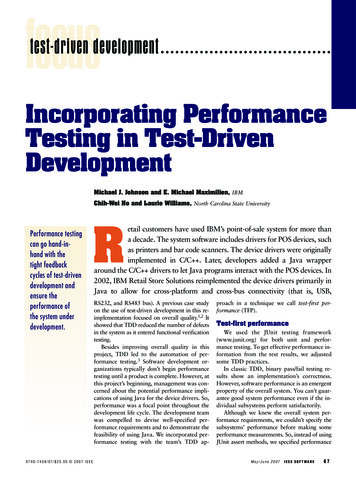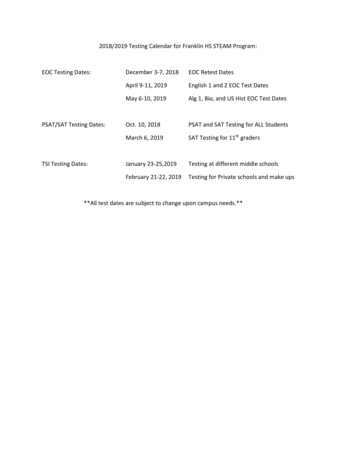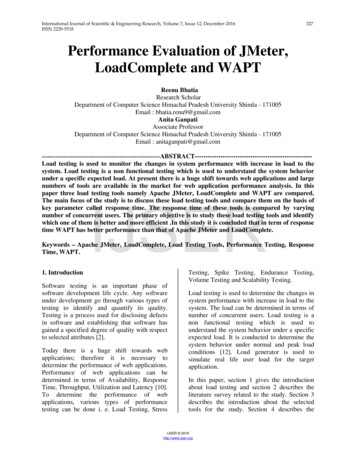
Transcription
focustest-driven developmentIncorporating PerformanceTesting in Test-DrivenDevelopmentMichael J. Johnson and E. Michael Maximilien, IBMChih-Wei Ho and Laurie Williams, North Carolina State UniversityPerformance testingcan go hand-inhand with thetight feedbackcycles of test-drivendevelopment andensure theperformance ofthe system underdevelopment.etail customers have used IBM’s point-of-sale system for more thana decade. The system software includes drivers for POS devices, suchas printers and bar code scanners. The device drivers were originallyimplemented in C/C . Later, developers added a Java wrapperaround the C/C drivers to let Java programs interact with the POS devices. In2002, IBM Retail Store Solutions reimplemented the device drivers primarily inJava to allow for cross-platform and cross-bus connectivity (that is, USB,R0740-7459/07/ 25.00 2007 IEEERS232, and RS485 bus). A previous case studyon the use of test-driven development in this reimplementation focused on overall quality.1,2 Itshowed that TDD reduced the number of defectsin the system as it entered functional verificationtesting.Besides improving overall quality in thisproject, TDD led to the automation of performance testing.3 Software development organizations typically don’t begin performancetesting until a product is complete. However, atthis project’s beginning, management was concerned about the potential performance implications of using Java for the device drivers. So,performance was a focal point throughout thedevelopment life cycle. The development teamwas compelled to devise well-specified performance requirements and to demonstrate thefeasibility of using Java. We incorporated performance testing with the team’s TDD ap-proach in a technique we call test-first performance (TFP).Test-first performanceWe used the JUnit testing framework(www.junit.org) for both unit and performance testing. To get effective performance information from the test results, we adjustedsome TDD practices.In classic TDD, binary pass/fail testing results show an implementation’s correctness.However, software performance is an emergentproperty of the overall system. You can’t guarantee good system performance even if the individual subsystems perform satisfactorily.Although we knew the overall system performance requirements, we couldn’t specify thesubsystems’ performance before making someperformance measurements. So, instead of usingJUnit assert methods, we specified performanceMay/June 2007IEEE SOFTWARE67
TeamSizeExperience (domainand programming language)CollocationTechnical leadershipCodeSizeLanguageUnit testingFigure 1. Projectcontext.68IEEE SOFTWARENine engineersSome team members inexperiencedDistributedDedicated coach73.6 KLOC (9.0 base and 64.6 new)JavaTest-driven developmentscenarios in the test cases and used them to generate performance log files. Developers and theperformance architect then examined the logs toidentify performance problems.We generated the logs with measurementpoints injected in the test cases. Whenever theexecution hit a measurement point, the test casecreated a time stamp in the performance log file.Subsequently, we could use these time stamps togenerate performance statistics such as the average and standard throughput deviation. Wecould enable or disable all of the measurementpoints via a single runtime configuration switch.We found the logs provided more informationthan the binary results and facilitated our investigation of performance issues.Another difference between classic TDD andTFP is the test designer. In classic TDD, the developers implementing the software design thetest cases. In our project, a performance architect who wasn’t involved in coding but had closeinteractions with the developers specified theperformance test cases. The performance architect was an expert in the domain with deepknowledge of the end users’ expectations of thesubsystems. The performance architect also hadgreater understanding of the software’s performance attributes than the developers and socould specify test cases that might expose moreperformance problems.For a TDD project to be successful, the testcases must provide fast feedback. However, oneof our objectives was to understand the system’sbehavior under heavy workloads,4 a characteristic that seemingly contradicts TDD. To incorporate performance testing into a TDD process, wedesigned two sets of performance test cases. Oneset could finish quickly and provide early warning of performance problems. The developers executed this set with other unit test cases. Theother set needed to be executed in a performancetesting lab that simulated a real-world situation.w w w . c o m p u t e r. o r g / s o f t w a r eThe performance architect ran this set to identifyperformance problems under heavy, simultaneous workloads or with multiple devices.The development team consisted of nine fulltime engineers, five in the US and four in Mexico. A performance architect in the US was alsoallocated to the team. No one had prior experience with TDD, and three were somewhat unfamiliar with Java. All but two of the nine fulltime developers were new to the targeteddevices. The developers’ domain knowledge hadto be built during the design and developmentphases. Figure 1 summarizes the project context.Applying test-first performanceFor ease of discussion, we divide the TFPapproach into three subprocesses: test design,critical test suite execution, and master testsuite execution.Test designThis process involves identifying importantperformance scenarios and specifying performance objectives. It requires knowing the system’s performance requirements and softwarearchitecture. In our case, the performance architect, with assistance from other domain experts, performed this process.Our test design process has three steps:identify performance areas, specify performance objectives, and specify test cases.Identify performance areas. You can specifysoftware performance on many types of resources, with different measurement units. Forexample, elapsed time, transaction throughput, and transaction response time are amongthe most common ways to specify softwareperformance. In our project, the importantperformance areas were the response time for typical input andoutput operations,the maximum sustainable throughput andresponse time for output devices, andthe time spent in different software layers.Specify performance objectives. We obtainedthe performance objectives from three sources.The first was previous versions of similar device driver software. A domain expert identifiedthe performance-critical device drivers. The objective for new performance-critical drivers wasto exceed the current performance in the field.
The objective for non-performance-criticaldrivers was to roughly meet the current performance in the field.The second source was the limitations of theunderlying hardware and software components.These components’ performance posed limitingfactors beyond which performance improvementhad little relevance. For example, figure 2 showsan execution time profile for a POS line displaydevice. In this example, we could impact the performance for only JavaPOS (www.javapos.com),the javax.usb API (http://javax-usb.org), and theJava Native Interface (JNI) layers. The combinedtime spent in the underlying operating systemkernel and in the USB hardware was responsiblefor more than half the latency from command tophysical device reaction. As long as the deviceoperation was physically possible and acceptable, we considered these latencies as forming abound on the drivers’ performance.Finally, marketing representatives distilledsome of the performance objectives from directcustomer feedback. This input tended to be numerically inexact but did highlight specific areaswhere consumers most desired performancerelated improvement from the previous release.Specify test cases. In this final step, we designedperformance test cases based on the specifiedobjectives. This step included defining the measurement points and writing JUnit test cases toautomatically execute the performance scenarios. We put the measurements points at the entry and exit points for each software layer. Weput another measurement point at the lowestdriver layer so that we could capture the timestamp of the event signal for the input from theJava virtual machine or native operating system.Performance test cases asserted additional startand stop measurement points.We specified two performance test suites.The critical test suite consisted of a small subset of the performance test cases used to testindividual performance-critical device drivers.The master test suite comprised the full set ofall performance test cases.Critical test suite executionDevelopers ran the critical test suite on theirown machines before committing their code tothe repository. They executed the suite usingJacl (http://tcljava.sourceforge.net), an interactive scripting language that allows manual interactive exercising of the classes by creatingLine display component timesWire external hardware 7.5%JavaPOS 5%javax.usb 20%Kernel internal hardware 47.5%Java Native Interface 20%Figure 2. Some limitingobjects and calling their methods. Figure 3a factors imposed by theshows the critical-test-suite execution process. hardware and operatingPerformance testing for a feature can’t rea- system layers.sonably start until the feature passes the TDDunit and functional tests. (the gray boxes in figure 3a). After the TDD test cases passed, the developers ran the critical test suite to generate performance logs. This suite provides preliminaryfeedback on potential performance issues associated with an individual device. To provide timelyfeedback, test case responsiveness is important inTDD. However, obtaining proper performancemeasurements usually requires running the software multiple times in different operating environments, sometimes with heavy workloads.Consequently, performance test cases tend to beslower than functional test cases. To get quickfeedback, the critical suite focused only on quicktesting of the performance-critical drivers.In classical TDD, developers rely on the“green bar” to indicate that an implementationhas passed the tests. When a test case fails, thedevelopment team can usually find the problemin the newly implemented feature. This delta debugging5 is an effective defect-removal techniquefor TDD. However, in performance testing, a binary pass/fail isn’t always best. We wanted developers to have an early indication of any performance degradation caused by a code changebeyond what a binary pass/fail for a specific performance objective could provide. Additionally,hard performance limits on the paths being measured weren’t always available in advance. So,the developers had to examine the performancelog files to discover performance degradationand other potential performance issues. The performance problem identification and removalprocess thus relied heavily on the developers’ expertise. After addressing the performance issues,May/June 2007IEEE SOFTWARE69
Test designTest designImplement a featureExecute master test suite NoFunctionaltests passed?Performance measurementsNosiveness and throughput under suchcircumstances.Multiple devices. The interaction amongtwo or more hardware devices mightcause unforeseen performance degradations. We designed some test cases to exercise multiple-device scenarios.Multiple platforms. We duplicated mosttest cases to measure the software’s performance on different platforms and indifferent environments.YesNoExecute tests forperformance-critical devicesPerformanceproblems found?YesPerformance log fileMake suggestions forperformance improvementPerformanceproblems found?Project finished?NoYesYesNoFix problemsCheck inProject finished?Yes(a)(b)Figure 3. The processfor (a) critical suiteexecution and(b) master suiteexecution.the developers checked in the code and beganimplementing another new feature.Master suite executionThe master suite execution included theseperformance test cases: 70IEEE SOFTWAREMultiple runs. Many factors, some thataren’t controllable, can contribute to software performance. So, performance measurements can differ each time the testcases are run. We designed some test casesto run the software multiple times to generate performance statistics.Heavy workloads. Software might behavedifferently under heavy workloads. We designed some test cases with heavy workloads to measure the software’s respon-w w w . c o m p u t e r. o r g / s o f t w a r eRunning these test cases could take significant time, and including them in the criticalsuites wasn’t practical. Additionally, it wasmore difficult to identify the causes of the performance problems found with these testcases. We therefore included these test cases inthe master test suite only.The performance architect ran the mastersuite weekly in a controlled testing lab. Figure3b shows this process.The performance architect started runningthe master suite and collecting performancemeasurements early in the development life cycle, as soon as enough functionality had beenimplemented. After collecting the measurements, the performance architect analyzed theperformance log file. If the performance architect found significant performance degradationor other performance problems, he would perform further analysis to identify the root causeor performance bottleneck. The architect thenhighlighted the problem to developers and suggested improvements when possible. The testing results were kept in the performancerecord, which showed the performance results’progress.A key element of this process was close interaction between the development team and theperformance architect. The performance architect participated in weekly development teammeetings. In these meetings, the developmentteam openly discussed the key changes in all aspects of the software. Additionally, because teammembers were geographically distributed, themeetings let everyone freely discuss any dependencies they had with other members from the remote sites and plan one-on-one follow-up. Theperformance architect could use the knowledgegained from the meetings to determine when asubsystem had undergone significant changesand thus pay more attention to the related performance logs.
Results a short receipt typical of a departmentstore environment (ADept),a long receipt typical of a supermarket(ASmkt), anda very long printout (MaxS).A fourth set (SDept) shows throughput withsynchronous-mode printing in a departmentstore environment.A code redesign to accommodate the human-interface device specification resulted in asignificant throughput drop between snapshots S1 and S2. However, the developmentteam received early notice of the performancedegradation via the ongoing performancemeasurements, and by snapshot S3 most ofthe degradation had been reversed. For thelong receipts where performance is most critical, performance generally trended upwardwith new releases.We believe that the upward performancetrend was due largely to the continuous feedback provided by the TFP process. Contraryto the information provided by postdevelopment optimization or tuning, the informationprovided by the in-process performance testing enabled a feedback-induced tendency todesign and code for better performance.Another indication of our early measurementapproach’s success is its improvement over previous implementations. We achieved the Javasupport for an earlier implementation simply bywrapping the existing C/C drivers with theJNI. This early implementation was a tactical interim solution for releasing Java-based drivers.However, customers used this tactical solution,Printer throughput tests (taller is better)3025Relative throughputBy the project’s end, we had created about2,900 JUnit tests, including more than 100performance tests.3 Performance-testing results showed improvement in most intermediate snapshots. We sometimes expected the opposite trend, because checking for andhandling an increasing number of exceptionconditions made the code more robust. Inpractice, however, we observed that thethroughput of successive code snapshots generally did increase.Figure 4 shows an example of receiptprinter throughput in various operating modesand retail environments. Three sets of resultsshow throughput with 0ADeptASmktMaxSOperating modeSDeptFigure 4. Performance tracking using snapshots of receipt printerthroughout tests. Three sets of results show throughput withasynchronous-mode printing: a short receipt typical of a departmentstore environment (ADept), a long receipt typical of a supermarket(ASmkt), and a very long printout (MaxS). The fourth set (SDept)shows throughput with synchronous-mode printing in a departmentstore environment.and we could have kept it as the mainstream offering if the new drivers didn’t match its performance levels. The tactical drivers’ performance was a secondary consideration and wasnever aggressively optimized, although the underlying C/C drivers were well tuned. The existence of the JNI-wrapped drivers let us run thesame JUnit-based performance test cases againstboth the JNI-wrapped drivers and the Java drivers for comparison. The tactical drivers’ performance provided a minimum acceptable threshold for performance-critical devices.Figure 5a shows results for the set ofthroughput tests in figure 4, this time comparing snapshot S3 to the previous implementation. The overall results were better with thenew code. Figure 5b shows the improvementin operation times of two less performancecritical device drivers. The line display was anintermediate case in that it didn’t receive theintense performance design scrutiny affordedthe printer, although bottom-line operationtime was important. We considered the cashdrawer operation time noncritical.Lessons learnedApplying a test-first philosophy in softwareperformance has produced some rewardingresults.May/June 2007IEEE SOFTWARE71
Device throughput (taller is better)Printer throughput tests (taller is better)162514Relative throughputRelative pt(a)ASmktMaxSOperating modeLine displayCash drawerDevice driverSDept(b)Figure 5. A comparison to the previous implementation of (a) performance-critical printer tasks and (b) less criticaland noncritical device tasks.First, when we knew performance requirements in advance, specifying and designingperformance test cases before coding appearsto have been advantageous. This practice letdevelopers know, from the beginning, thoseoperations and code paths considered performance critical. It also let them track performance progress from early in the development life cycle. Running the performance testcases regularly increased developers’ awareness of potential performance issues. Continuous observation made the developers moreaware of the system’s performance and couldexplain the performance increase.6We also found that having a domain expertspecify the performance requirements (whereknown) and measurement points increasedoverall productivity by focusing the team onareas where a performance increase wouldmatter. This directed focus helped the teamavoid premature optimization.The performance architect could developand specify performance requirements andmeasurement points much more quickly thanthe software developers. Also, limiting measurement points and measured paths to whatwas performance sensitive in the end productlet the team avoid overinstrumentation. Havinga team member focused primarily on performance also kept the most performance-criticaloperations in front of the developers. This technique also occasionally helped avoid performance-averse practices, such as redundant creation of objects for logging events.A third lesson is that periodic in-system72IEEE SOFTWAREw w w . c o m p u t e r. o r g / s o f t w a r emeasurements and tracking performancemeasurements’ progress increased performance over time.This practice provided timely notificationof performance escapes (that is, when someother code change degraded overall performance) and helped isolate the cause. It also letdevelopers quickly visualize their performanceprogress and provided a consistent way to prioritize limited development resources ontothose functions having more serious performance issues. When a critical subsystem’s performance was below the specified bound, theteam focused on that subsystem in the middleof development. The extra focus and designled to the creation of an improved queuing algorithm that nearly matched the targeted device’s theoretical limit.Our performance-testing approach required manually inspecting the performance logs. During the project’s development, JUnit-based performance testing tools,such as JUnitPerf, weren’t available. Such toolsprovide better visibility of performance problemsthan manual inspection of performance logs. Although we believe manual inspection of performance trends is necessary, specifying the bottom-line performance in assert-based test casescan complement the use of performance log files,making the TFP testing results more visible to thedevelopers. We’re investigating the design ofassert-based performance testing to improve theTFP process.
Another direction of future work is automatic performance test generation. In this project, we relied on the performance architect’sexperience to identify the execution paths andmeasurement points for performance testing.We can derive this crucial information for performance testing from the performance requirements and system design. We plan to findguidelines for specifications of performance requirements and system design to make the automation possible.About the AuthorsMichael J. Johnson is a senior software development engineer with IBM in ResearchTriangle Park, North Carolina. His recent areas of focus include performance analysis, performance of embedded systems, and analysis tools for processors. He received his PhD in mathematics from Duke University. He’s a member of the IEEE and the Mathematical Association ofAmerica. Contact him IBM Corp., Dept. YM5A, 3039 Cornwallis Rd., Research Triangle Park, NC27709; mjj@us.ibm.com.Chih-Wei Ho is a PhD candidate at North Carolina State University. His research interestsare performance requirements specification and performance testing. He received his MS incomputer science from NCSU. Contact him at 2335 Trellis Green, Cary, NC 27518; dright@acm.org.AcknowledgmentsWe thank the IBM device driver developmentteam members, who implemented the performancetests described in this article. We also thank theRealSearch reading group at North Carolina StateUniversity for their comments. IBM is a trademarkof International Business Machines Corporation inthe United States or other countries or both.References1. E.M. Maximilien and L. Williams, “Assessing TestDriven Development at IBM,” Proc. 25th Int’l Conf.Software Eng. (ICSE 03), IEEE CS Press, 2003, pp.564–569.2. L.E. Williams, M. Maximilien, and M.A. Vouk, “TestDriven Development as a Defect Reduction Practice,”Proc. 14th Int’l Symp. Software Reliability Eng., IEEECS Press, 2003, pp. 34–35.3. C.-W. Ho et al., “On Agile Performance RequirementsSpecification and Testing,” Proc. Agile 2006 Int’l Conf.,IEEE Press, 2006, pp. 47–52.4. E.J. Weyuker and F.I. Vokolos, “Experience with Performance Testing of Software Systems: Issues, an Approach, and Case Study,” IEEE Trans. Software Eng.,vol. 26, no. 12, Dec. 2000, pp. 1147–1156.5. A. Zeller and R. Hildebrandt, “Simplifying and Isolating Failure-Inducing Input,” IEEE Trans. SoftwareEng., vol. 28, no. 2, 2002, pp. 183–200.E. Michael Maximilien is a research staff member in the Almaden Services Researchgroup at the IBM Almaden Research Center. His research interests are distributed systems andsoftware engineering, with contributions to service-oriented architecture, Web services, Web2.0, service mashups, and agile methods and practices. He received his PhD in computer science from North Carolina State University. He’s a member of the ACM and the IEEE. Contacthim at the IBM Almaden Research Center, 650 Harry Rd., San Jose, CA 95120; maxim@us.ibm.com.Laurie Williams is an associate professor at North Carolina State University. Her re-search interests include software testing and reliability, software engineering for security, empirical software engineering, and software process, particularly agile software development. Shereceived her PhD in computer science from the University of Utah. She’s a member of the ACMand IEEE. Contact her at North Carolina State Univ., Dept. of Computer Science, Campus Box8206, 890 Oval Dr., Rm. 3272, Raleigh, NC 27695; williams@csc.ncsu.edu.6. G.M. Weinberg, The Psychology of Computer Programming, Dorset House, 1998, pp. 31.For more information on this or any other computing topic, please visit ourDigital Library at www.computer.org/publications/dlib.VISIT US ONLINEw w w . c o m p u t e r. o r g /softwareThe authority on translating software theory into practice, IEEE Software positionsitself between pure research and pure practice, transferring ideas, methods, andexperiences among researchers and engineers. Peer-reviewed articles and columnsby real-world experts illuminate all aspects of the industry, including process improvement, project management, development tools, software maintenance, Webapplications and opportunities, testing, usability, and much more.May/June 2007IEEE SOFTWARE73
on the use of test-driven development in this re-implementation focused on overall quality.1,2 It showed that TDD reduced the number of defects in the system as it entered functional verification testing. Besides improving overall quality in this project, TDD led to the automation of per-formance testing.3 Software development or-










